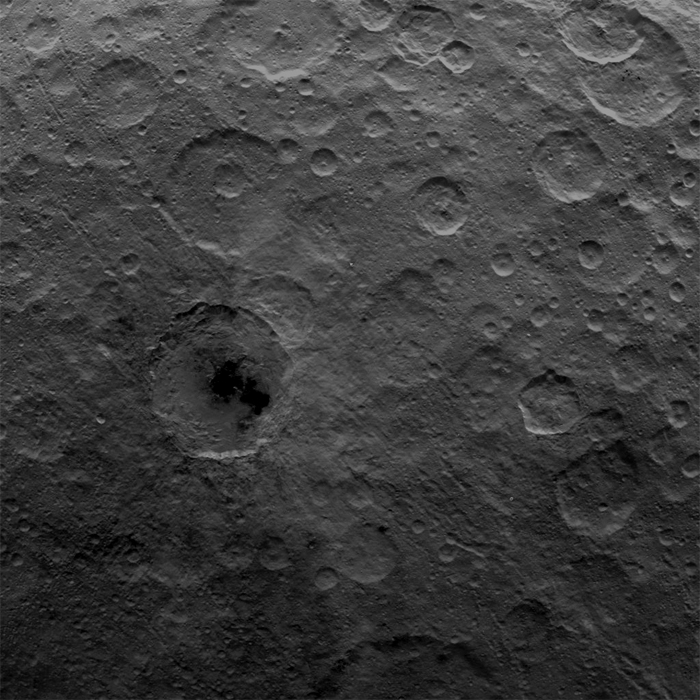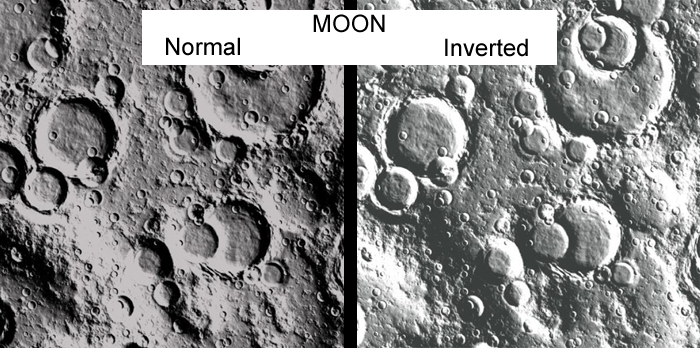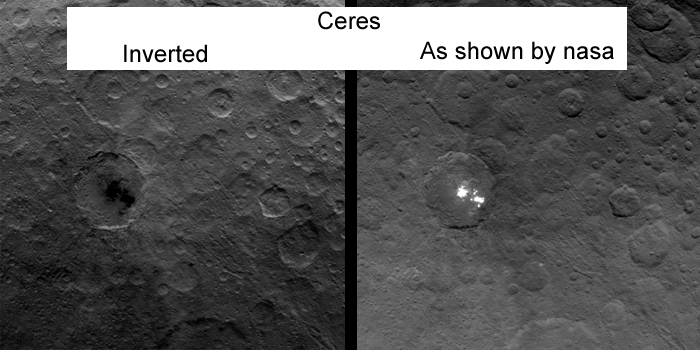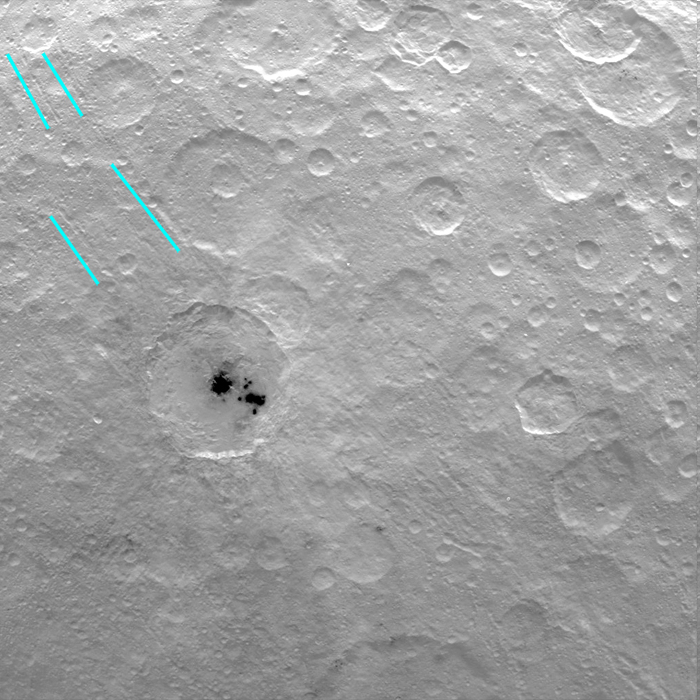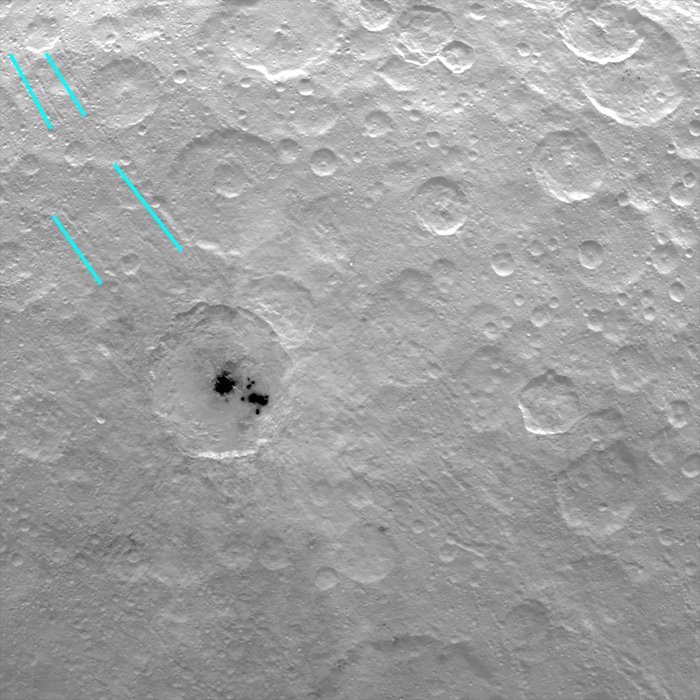It looks like you're using an Ad Blocker.
Please white-list or disable AboveTopSecret.com in your ad-blocking tool.
Thank you.
Some features of ATS will be disabled while you continue to use an ad-blocker.
share:
In the nasa image the shadows are along the "bottom" rim of the craters. That's why it looks weird. When you inverted it, it gave the effect of
changing the "shadow" to the top rim of the craters, as if it were lit from above, making it look more natural. The other poster was right, rotating
it 180 degrees gives it the same effect by moving the positions of the shadows, and making it look more natural.
Although dark spots Are more likely than bright spots... but not so much as to make bright spots a near impossibility... but still you could be onto something. Personally, for me, even if they found a "city" down there, I would be wondering if it was built by the "shadow gov/breakaway civ" sometime in the last decade or two, just to deceive us into accepting the "knowledge" found there... maybe even complete with genetically engineered "aliens" ready to share this so called "knowledge". I'm not saying it would be a foregone conclusion for me, just that I have a healthy distrust and its something I would have to think through.
Although dark spots Are more likely than bright spots... but not so much as to make bright spots a near impossibility... but still you could be onto something. Personally, for me, even if they found a "city" down there, I would be wondering if it was built by the "shadow gov/breakaway civ" sometime in the last decade or two, just to deceive us into accepting the "knowledge" found there... maybe even complete with genetically engineered "aliens" ready to share this so called "knowledge". I'm not saying it would be a foregone conclusion for me, just that I have a healthy distrust and its something I would have to think through.
I love optical illusions! Here's one of my favourites
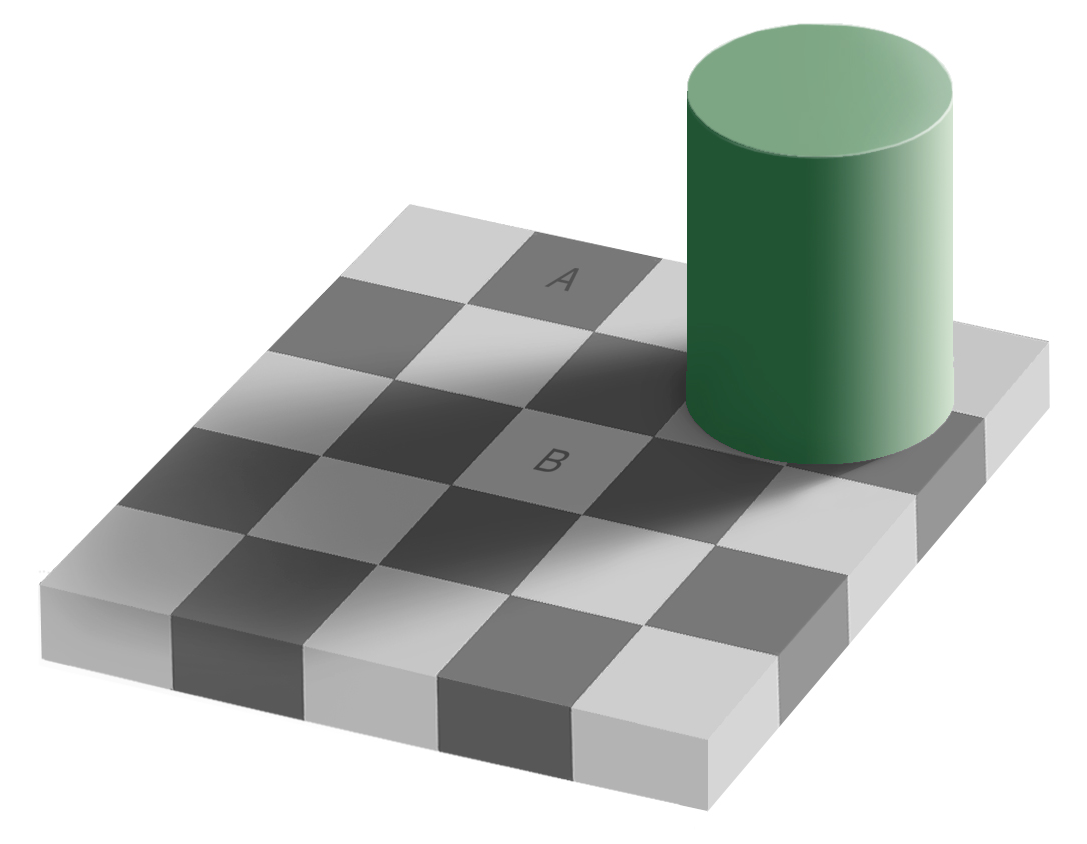
Which square is brightest, A or B?

Which square is brightest, A or B?
originally posted by: MarsIsRed
I love optical illusions! Here's one of my favourites
Which square is brightest, A or B?
That one is a good one, and only when you pop it into software and move one to the other do you get that moment.. love it..
I also love this illusion. I made one of these, and it's freaky... the mind is so easily fooled..
originally posted by: VoidHawk
I was just looking at another thread about Ceres and couldn't help notice something in the images.
This is the original direct from NASA, the only alterations I've made are a reduction in size so that it fits ats forum, and I've added some red lines.
Notice that each red line runs parallel to a straight line feature that's just to the right of each red line.
Its those straight line features that caught my eye.
How are they made?
Normally such features are the result of a piece of rock rolling across the surface that leaves a furrow as it travels. But in NASA's picture these features are raised!
So, I inverted the picture!
I think this picture looks much more natural, and those straight line features are now furrows, just as we'd expect!
Also, the bright spots that have intrigued so many people are now black spots! Much more likely than bright spots!
Please look closely at both pictures, which do you think looks more natural?
The next picture is of the moon. On the left is the original picture, on the right I have inverted it. Notice how the craters are now raised, just like the pictures of Ceres!
Compare it with the picture below of Ceres.
Look at the inverted picture of the Moon and compare it with the picture that nasa presents of Ceres.
So what's more likely, bright spots on Ceres or dark spots?
Has nasa inverted the picture so that bright spots appear? causing the public to be more willing to supply nasa with more money?
This is ats and I reserve the right to wear my CT hat
I'm sorry but I have to debunk this because Ceres's bright spots had already been photographed with Hubble.

Furthermore ESA's Herschel space telescope detected water vapor on Ceres a year ago.
So they're not inverted images and if I were willing to bet, I'd bet on ice.
Do you REALLY think the astronomical community is so stupid that they couldn't easily detect something as scientifically wrong as inverted imagery?
Really?
edit on 11-6-2015 by JadeStar because: (no reason given)
I see that the actual light source is on the opposite sides of the craters in each of those first 2 photos...ones appears to be coming from a lower
left, and the other seems to be coming from a middle right to upper right direction. and lets not forget that these photos were not taken with
everything at a standstill... moon was moving, craft was moving....as far as the reflection in the center crater, it's just a matter of semi-shiny
rock that when the angle of light hitting it changes, it loses it's shine. happens all the time on a variety of materials. go outside at night and
look at the windshield of a car. you can walk around it, and eventually you will reach a point where light is being reflected off of it where it was
dark before.
So it's not a crater with bright spots, it's a dome with dark spots?
OP --
If this image is the fake one:
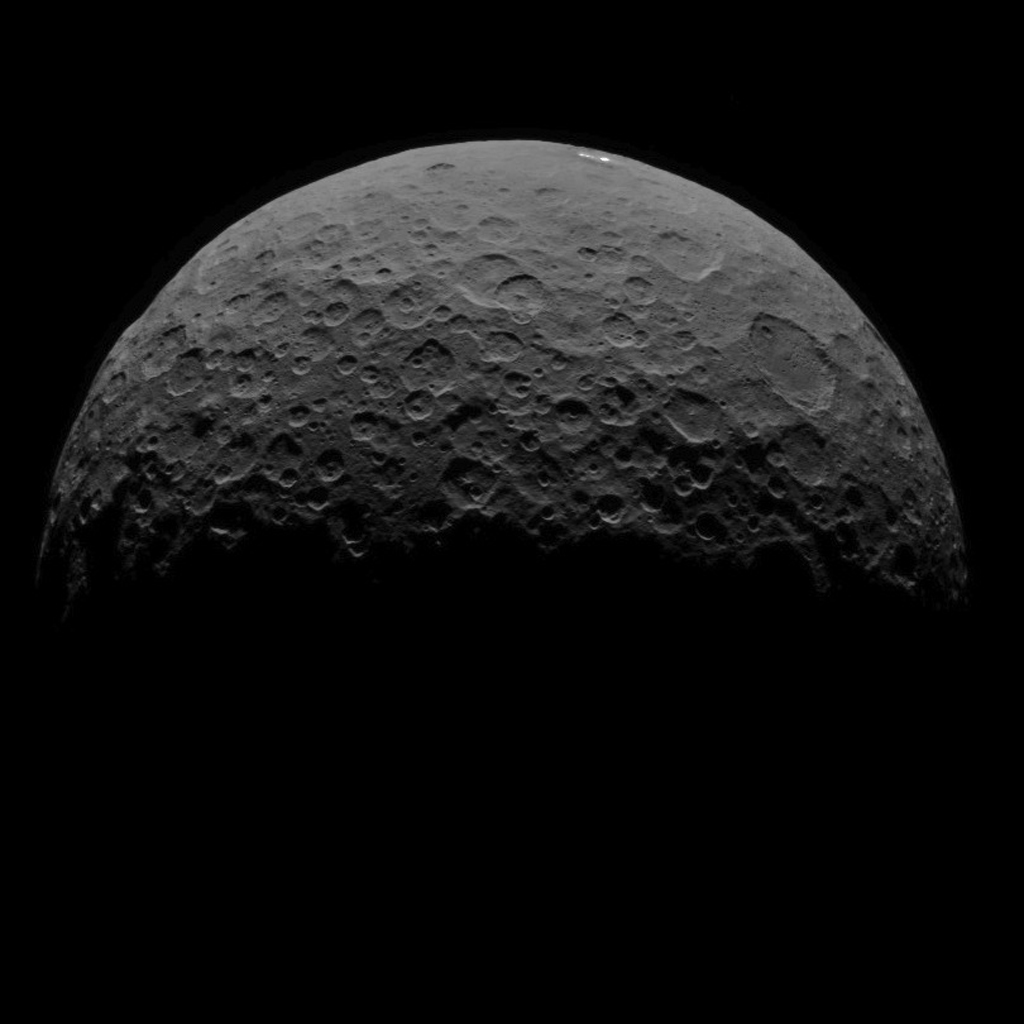
And it needs to be inverted like this (below) to see the "real" image:
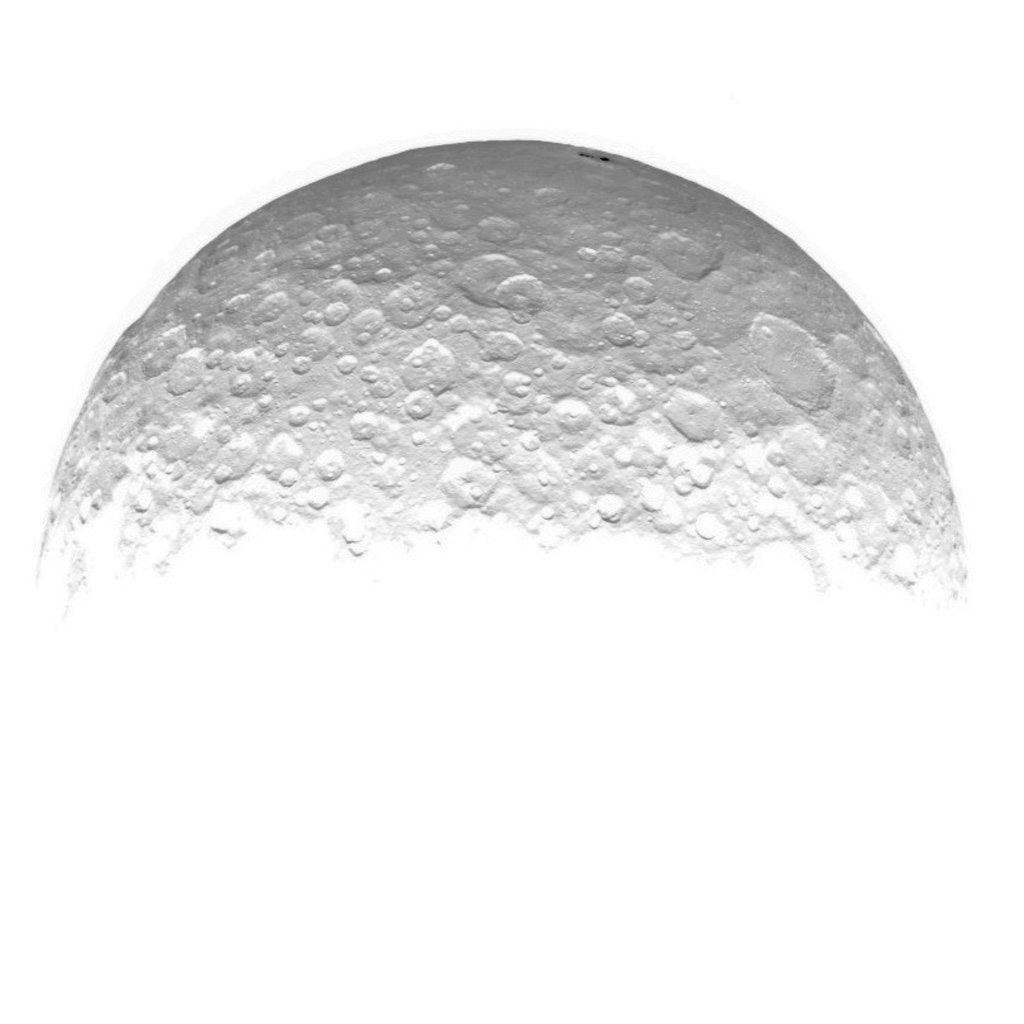
Then why is the part of Ceres on the dark side of the terminator line all white?
If this image is the fake one:

And it needs to be inverted like this (below) to see the "real" image:

Then why is the part of Ceres on the dark side of the terminator line all white?
a reply to: Soylent Green Is People
The OP is inverting AND darkening which some are missing here.
But your point is right. When the image is inverted and darkened the terminator should not be the part which is brighter. Since it's lit up, it shouldn't even be a terminator.
One thing I'll add again is when you invert and darken the image you're throwing out image data to make the bright spot look more like a lake. The first thing I noticed in the OP's inverted image was the "lake". The crevices (or ridges?) assist the illusion because they resemble something like channels, or at least in some way give it a lake-ish feel.
It does bring out the details around the spot. That's interesting. What created those features? Is it standard fare in a crater? I'm not sure if those are crevices or ridges in the original image which surround hte spot.
The details around the spot(s) might hint what they're. Probably geologic in nature? It doesn't look smooth; looks ragged and branching.
The OP is inverting AND darkening which some are missing here.
But your point is right. When the image is inverted and darkened the terminator should not be the part which is brighter. Since it's lit up, it shouldn't even be a terminator.
One thing I'll add again is when you invert and darken the image you're throwing out image data to make the bright spot look more like a lake. The first thing I noticed in the OP's inverted image was the "lake". The crevices (or ridges?) assist the illusion because they resemble something like channels, or at least in some way give it a lake-ish feel.
It does bring out the details around the spot. That's interesting. What created those features? Is it standard fare in a crater? I'm not sure if those are crevices or ridges in the original image which surround hte spot.
The details around the spot(s) might hint what they're. Probably geologic in nature? It doesn't look smooth; looks ragged and branching.
edit
on 11-6-2015 by jonnywhite because: (no reason given)
originally posted by: VoidHawk
Normally such features are the result of a piece of rock rolling across the surface that leaves a furrow as it travels. But in NASA's picture these features are raised!
Nope, they look like furrows to me and to lots of other people. It's not that difficult to confirm, if you look at the crater's lit and shadowed parts to establish where sunlight is coming from (hint - from below the image).
Therefore, your whole argument construct falls apart. The image looks how it should look, and NASA haven't inverted anything.
In connection with Ceres, the only thing I saw them inverting was the false-colour global map of Ceres, and that was probably done to better distinguish between the variations in surface colour. They did specify that the usual order of the colours had been reversed.
originally posted by: jonnywhite
It does bring out the details around the spot. That's interesting. What created those features? Is it standard fare in a crater? I'm not sure if those are crevices or ridges in the original image which surround hte spot.
The details around the spot(s) might hint what they're. Probably geologic in nature? It doesn't look smooth; looks ragged and branching.
The bright spots as we see them in the image are not the actual shape of what is there. The bright spots are over-exposed pixels caused by a reflection that is brighter than the image sensors can detect at the exposure times being used. The real shape of whatever is causing that reflection is obscured by the over-exposed pixels.
We have to wait to get better (and less over-exposed) images to see what the shape of the reflective material really is.
a reply to: VoidHawk
I think you have something there, Voidhawk. I did notice it, but didn't think a lot about it. Usually, when I view pics where the craters look raised, if I continue to look at it, I can see that they're really craters. However, that's not the case with this one. No matter how long I stare at it, the craters continue to look raised to me. I've never had that happen before, that I can remember.
I think you have something there, Voidhawk. I did notice it, but didn't think a lot about it. Usually, when I view pics where the craters look raised, if I continue to look at it, I can see that they're really craters. However, that's not the case with this one. No matter how long I stare at it, the craters continue to look raised to me. I've never had that happen before, that I can remember.
originally posted by: VoidHawk
I was just looking at another thread about Ceres and couldn't help notice something in the images.
This is the original direct from NASA, the only alterations I've made are a reduction in size so that it fits ats forum, and I've added some red lines.
Notice that each red line runs parallel to a straight line feature that's just to the right of each red line.
Its those straight line features that caught my eye.
How are they made?
Normally such features are the result of a piece of rock rolling across the surface that leaves a furrow as it travels. But in NASA's picture these features are raised!
So, I inverted the picture!
I think this picture looks much more natural, and those straight line features are now furrows, just as we'd expect!
Also, the bright spots that have intrigued so many people are now black spots! Much more likely than bright spots!
Please look closely at both pictures, which do you think looks more natural?
The next picture is of the moon. On the left is the original picture, on the right I have inverted it. Notice how the craters are now raised, just like the pictures of Ceres!
Compare it with the picture below of Ceres.
Look at the inverted picture of the Moon and compare it with the picture that nasa presents of Ceres.
So what's more likely, bright spots on Ceres or dark spots?
Has nasa inverted the picture so that bright spots appear? causing the public to be more willing to supply nasa with more money?
This is ats and I reserve the right to wear my CT hat
The reason you think it's more natural is because the human mind is conditioned to accept light as coming from above (the sun)...
But since we are not standing on the surface of mars and photographing these things but the craft is orbiting around it, the direction of light is not a given.
Therefore "unnatural" light can easily occur every now and again, completely depending on the Mars, Sun, Craft relationship when the photo is snapped.
The is also the reason that when you want to make a scary scene in a movie, you will often subject the scary character with light from below, since it is unnatural to us.
No magic here.... just someone displaying and underlining what I just said.
NASA would never lie to us, they are our friends, we all know them and have for years, You can trust NASA, trust me.....................that's was
sarcasm before anyone starts trying to disprove that with links.
originally posted by: Foderalover
NASA would never lie to us, they are our friends, we all know them and have for years, You can trust NASA, trust me.....................that's was sarcasm before anyone starts trying to disprove that with links.
And what does your post have to do with the images being discussed?
It's kinda lame to take an overarching leap of logic like that, and use it to judge any and all subjects being brought up for discussion here on ATS...
new topics
-
Orange County Makes Shoplifting a Felony
Other Current Events: 1 hours ago -
It's Offical Now
US Political Madness: 3 hours ago -
The reason it works is.....
General Chit Chat: 4 hours ago -
Dick Van Dyke saved from Wildfire by neighbours on his 99th birthday
People: 6 hours ago
top topics
-
It's Offical Now
US Political Madness: 3 hours ago, 8 flags -
Orange County Makes Shoplifting a Felony
Other Current Events: 1 hours ago, 6 flags -
The reason it works is.....
General Chit Chat: 4 hours ago, 5 flags -
Dick Van Dyke saved from Wildfire by neighbours on his 99th birthday
People: 6 hours ago, 3 flags
active topics
-
Post A Funny (T&C Friendly) Pic Part IV: The LOL awakens!
General Chit Chat • 7953 • : underpass61 -
Orange County Makes Shoplifting a Felony
Other Current Events • 7 • : Echo007 -
Dick Van Dyke saved from Wildfire by neighbours on his 99th birthday
People • 1 • : soulrevival -
The reason it works is.....
General Chit Chat • 3 • : BeyondKnowledge3 -
It's Offical Now
US Political Madness • 7 • : CriticalStinker -
London Christmas Market BANS Word ‘Christmas’
Social Issues and Civil Unrest • 44 • : Oldcarpy2 -
The Acronym Game .. Pt.4
General Chit Chat • 1024 • : JJproductions -
Christmas Dinner ??
Food and Cooking • 17 • : putnam6 -
1 Billion dollars
General Entertainment • 12 • : Blueracer -
Trump says ownership of Greenland 'is an absolute necessity'
Other Current Events • 49 • : Xtrozero


